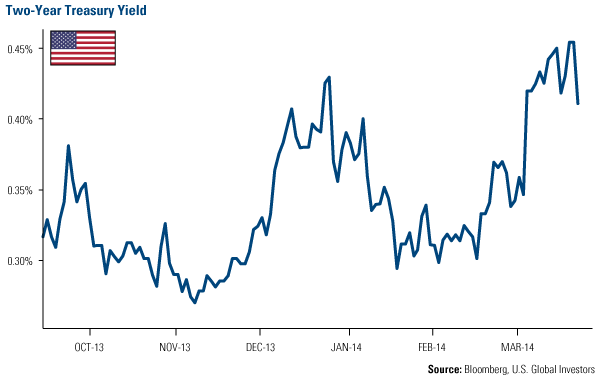The Economy and Bond Market Radar (April 7, 2014)
Treasuries rallied following the March U.S. jobs report, with five- and seven-year notes leading the gains. Payrolls rose 192,000 last month after a gain of 197,000 in February and larger than originally estimated. Private employment, which excludes government jobs, surpassed the pre-recession peak for the first time. Employment in January and February was revised higher, showing that the effect of inclement winter weather on the labor market was less severe than previously thought. Earlier in the week, Federal Reserve Chairman Janet Yellen said accommodative policies will be needed for “some time.”
Strengths
- The rate of defaults on high-yield debt is low and falling. Even if companies that default and are liquidated, the recovery rate on their debt is higher than was seen three years ago.
- The ratio of debt rating upgrades to downgrades is running above one. A portfolio of high-yield bonds that have been upgraded outperformed the overall basket by around 13 percent in the last four years.
- Following the relentless rally in Greek bonds seen over the past two years, ratings agency Moody’s is widely expected to lift the rating outlook on the eurozone’s weakest link.
Weaknesses
- Housing prices continue to ease in China, as the National Bureau of Statistics (NBS) survey shows the month-over-month increase falling to an 18-month low of 0.3 percent in February. This suggests that the potential property bubble from 2012 to 2013 has been deflated.
- Bonds are showing the challenges central bankers face when it comes to creating sustainable economic growth amid persistent low inflation.
- Ukraine’s credit rating was cut by Moody’s Investors Service, which said that escalating political tensions along with the withdrawal of Russian financial support are weakening the country’s fiscal strength.
Opportunities
- Federal Reserve Chairman Janet Yellen backpedaled from her comments last week that rates will be raised soon after the end of quantitative easing (QE). Clearly, the Fed is watching the market just as the market is watching the Fed.
- For low-quality corporate bonds, better economic data is supportive. Thus, the credit spreads should narrow against Treasuries.
- Better U.S. data, especially relative to the eurozone, will likely push the dollar/euro exchange rate back into its financial “fair value” range of 1.26 to 1.35, according to ISI.
Threats
- The opponents of hard-nosed sanctions on Russia argue that there is little scope for action as oil, the country’s chief export, is easy to store, ship, and trade. But to sell its oil, Russia needs access to the world’s financial system. Its companies still need to borrow on the bond market, to which they had enjoyed access thanks to QE and the fact that Russia has the largest weight in the MSCI EM fixed-income index. Removal from equity and fixed income indices could deal a serious blow to an era of cheap financing and Russia’s military ambitions.
- Portugal weighs the risks by going alone and not bothering with the precautionary credit line advocated by the European Union. Portugal is trying to regain full access to debt markets after relying on 78 billion euros of emergency money the past three years.
- Global sales of structured notes linked to inflation fell to the lowest in 12 years as sluggish price growth in the world’s biggest economies deters potential investors.













